How electricity works
How does electricity work. In this article we’ll be learning the basic concept behind how electricity works according to classical theory. We’ll cover Atoms, electrons, protons, neutrons then move onto the difference between conductors and insulators, wires and cables, circuits, volts and voltage, currents and amps, resistors, resistance and ohms, induction and inductors, transformers, capacitors and finally the difference between AC and DC power. These are the basics to grasp in order to understand how electricity works before moving onto more advanced areas of electrical and electronic engineering. Scroll to the bottom to watch the video tutorial on this subject
The Atom
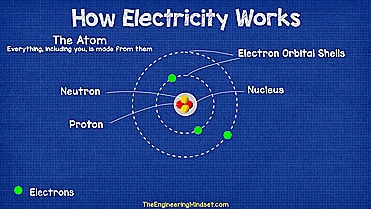
Everything is made from Atoms, including you! Different materials have different types of atoms. At the centre of an Atom is the Nucleus, this houses two particles known as the Neutron and Proton. The Neutron has no electrical charge but the Proton has a positive electrical charge.
Surrounding the Nucleus are different layers of orbital shells which act like flight paths for another type of particle known as the electron. The electrons travel long these paths much like satellites orbit around our planet, except that the electrons travel at almost the speed of light.
The negative charge of the neutrons is attracted to the positive charge of the Proton which keeps the electrons in orbit. Each orbital shell can hold a set number of electrons. The number of Protons, Neutrons and Electrons an Atom has tells us which material it is and the combination is unique for each material.
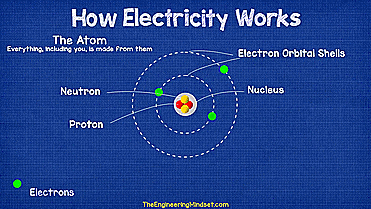
Atoms hold onto their electrons tightly but some materials will hold onto their electrons more tightly than others. The outer most orbital shell is known as the Valance shell and in this shell some materials will have loosely bound electrons which can float to other Atoms.
Conductors and insulators
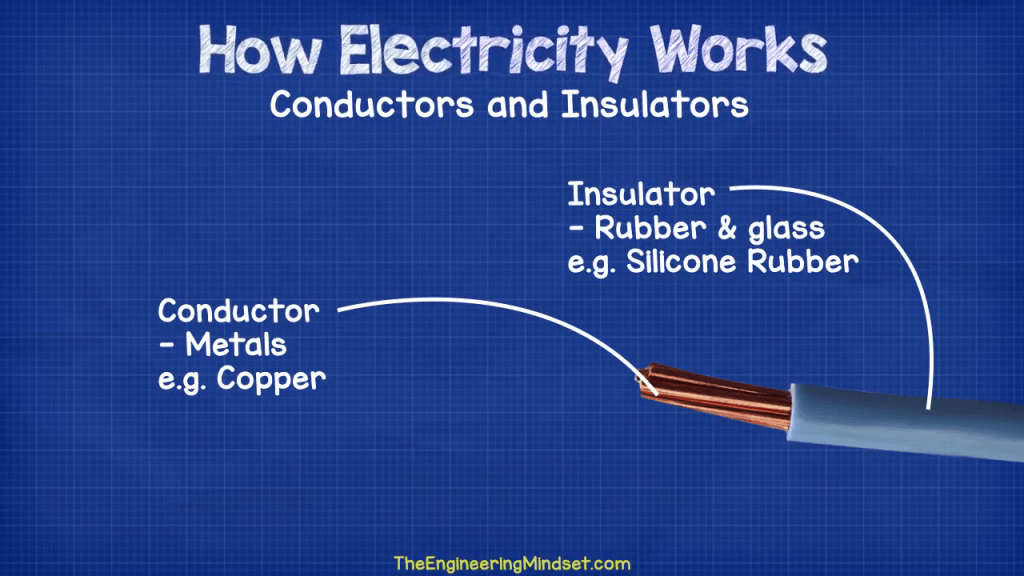
Materials which can pass electrons are known as “Conductors” meaning they can conduct electricity. Most Metals are conductors. Atoms which do not have free electrons are known as insulators, materials like glass and rubber are good examples of this.
We can combine Conductors and Insulators together to safely use electricity. This is is done by surrounding the conductor with an insulator, this allows electrons to flow but it restricts where they can flow to. This is how a cables and wires work.
Wires and Cables
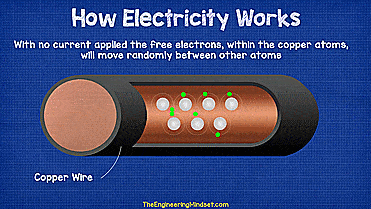
If we look inside a slice of Copper cable we would see the free electrons of the atoms move from one atom to another, however this occurs randomly in any direction.
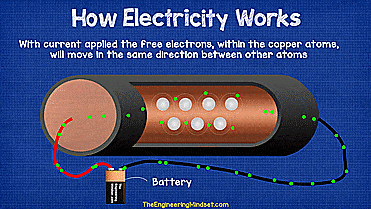
If the slice of cable were then connected in a closed circuit to a source of power such as a battery, then the voltage will force the free electrons to move and this will cause them to all flow in the same direction, to try and get back to the other terminal of the battery.
Circuits
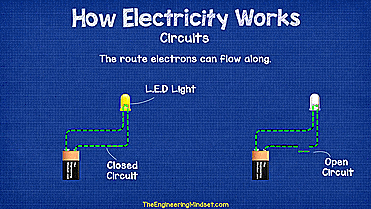
The term circuits refers to a route which the electrons can flow along to get between the two terminals of the power source (Positive and Negative).
When a circuit is closed then electrons can flow from one terminal to the other. When a circuit is open then there is a gap in the circuit so electrons can’t flow.
We can place electrical components in the path of the free electrons which flow in a circuit. This will force the electrons to flow through the component and this can be used to perform work such as generate light.
Volts and Voltage
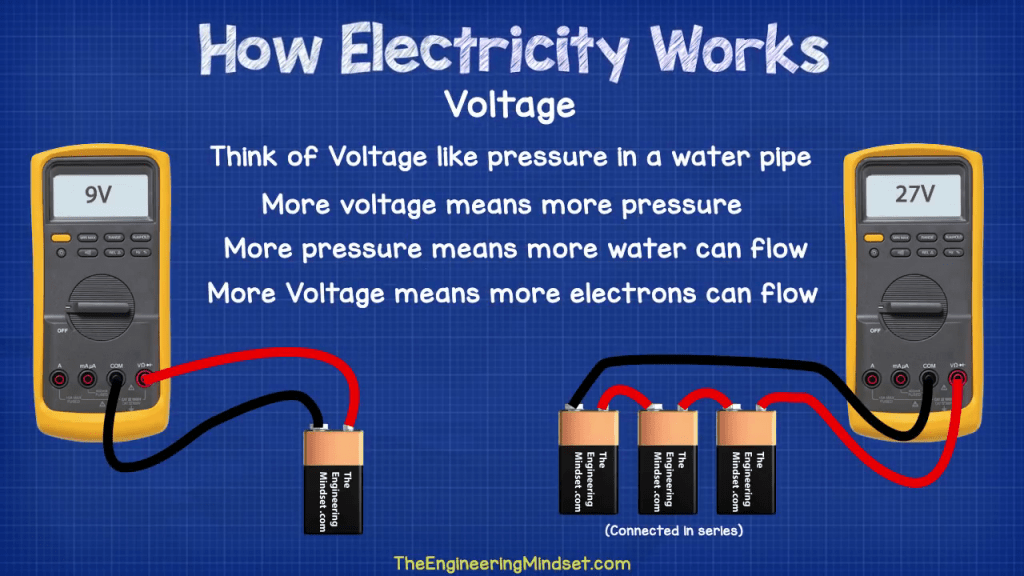
Voltage is a pushing force of electrons in a circuit, much like pressure in water pipe. The more pressure you have the more water can flow. The more voltage you have the more electrons can flow.
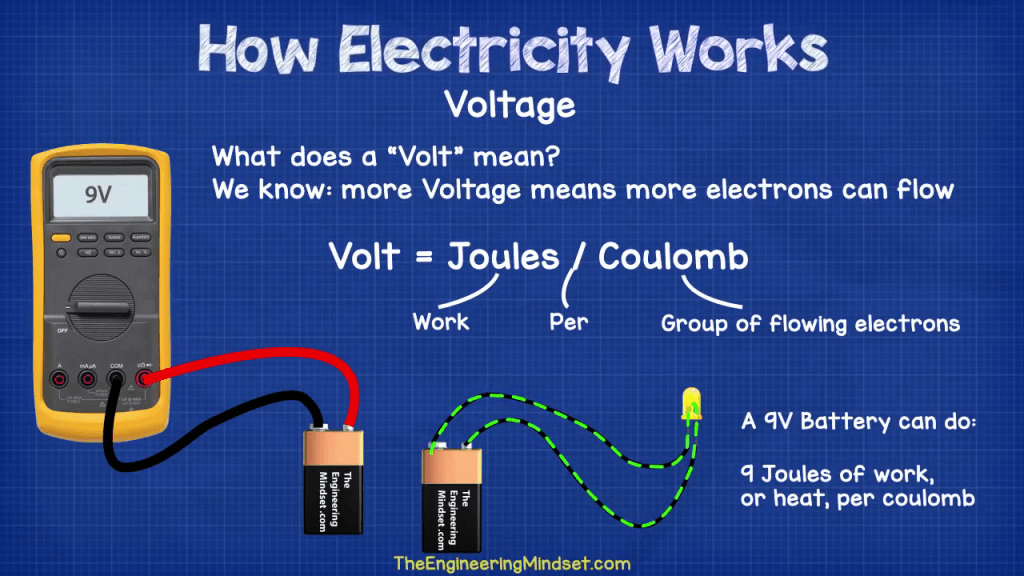
A Volt is a Joule per Coulomb. A Joule is a measurement of energy or work. A Coulomb is a group of flowing electrons.
A 9V battery can provide 9 Joules of energy, in the form of work or heat, per group of electrons that flow from one terminal of the battery to the other. In this case the electrons from one terminal of the battery, through the L.E.D bulb and then into the other terminal of the battery. Therefore 9 Joules of light and heat is produced by the bulb.
Current, Amperes and Amps
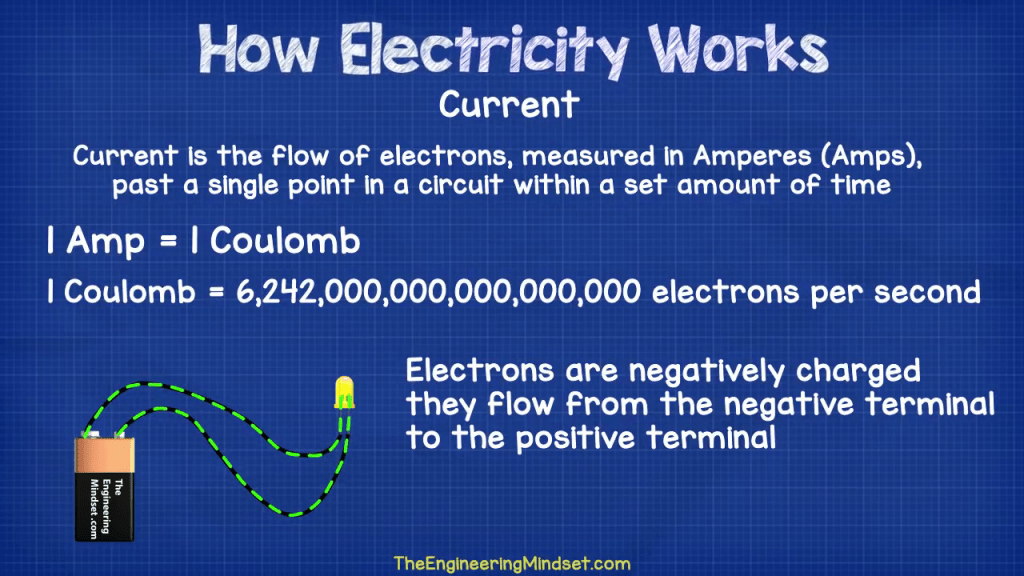
Current is the flow of electrons. When a circuit is closed then a current of electrons can flow and when a circuit is open then no current can flow. We can measure the flow of electrons just like you can measure the flow of water through a pipe.
To measure the flow of electrons we use the unit of Amperes or Amps for short. 1 Amp means 1 Coulomb per second and one coulomb equals 6,242,000,000,000,000,000 electrons per second. This is an extremely large number which is why they are grouped together and called Amps.
Resistors and Resistance
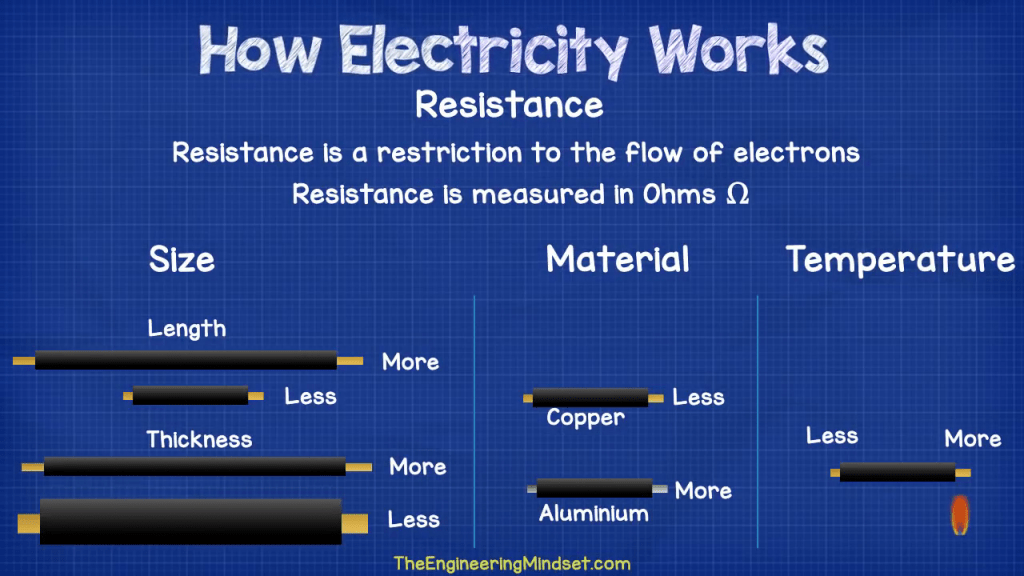
Resistance is a restriction to the flow of electrons in a circuit. Wires which carry the current will naturally have some resistance. The longer the wire the greater the resistance. The thicker the wire the less the resistance. The resistance to the flow of electrons is different for each material, the temperature of the material will also affect the level of resistance.
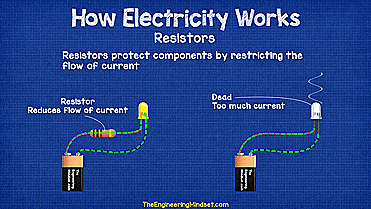
Electrical circuit use specially designed components known as resistors to purposely restrict the flow of electrons. This is used to protect other electrical components from receiving too much current and it can also be used to generate light and heat such as in an incandescent light bulb.
Resistance occurs when electrons collide with atoms. The number of collisions varies by material, some materials such as Iron will have a very high rate of collisions whereas other materials such as copper has much fewer collisions.
When collisions occur the atoms generate heat and at a certain temperature the material will then start to produce light as well as heat, which is how the incandescent lamps work.
Inductors and induction
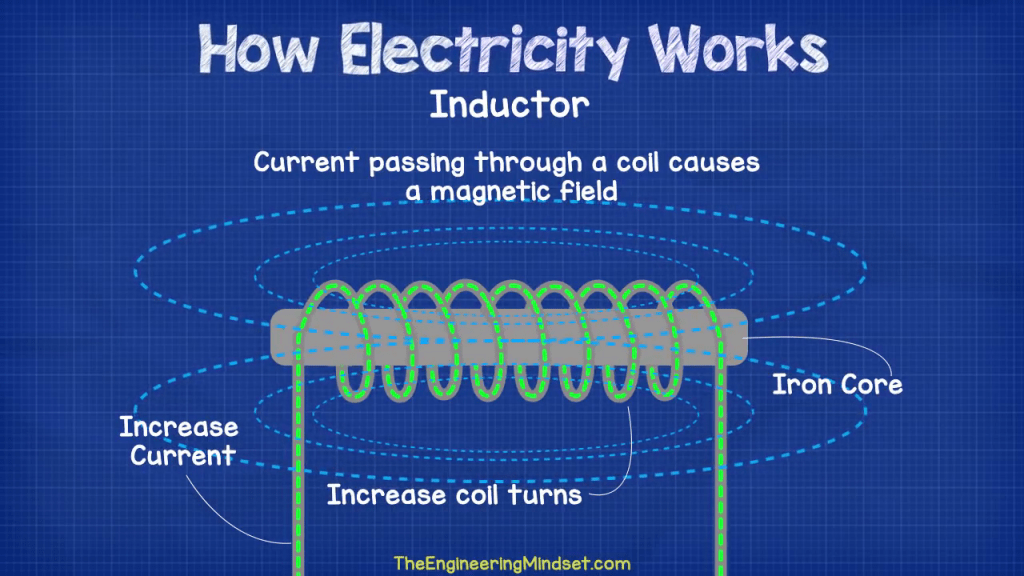
When a wire is wrapped in a coil, it will produce a magnetic field as the current passes through it. The cable would naturally create the magnetic field, its just intensified by the shape of the coil. By wrapping the wire in a coil, the magnetic field becomes so strong that it starts to affect the electrons within the wire
We can increase the intensity of the magnetic field simply by wrapping the wire around an iron core. We can increase the number of rotations within the coil and we can also increase the amount of current passing through the circuit to produce larger and stronger magnetic fields. This is how electromagnets work, its also the basis of how induction motors work. Click here for more information of the working principle of induction motors.

When a magnetic field is passed across a coil of wire, it will induce a voltage into the wire caused by an induced electromotive force which is pushing the electrons in a certain direction. If the coil is connected to a circuit this will cause a current to flow. This is the basis of how an AC generator works and the power available in the plug sockets of your home was produced in a very similar way.
Transformer
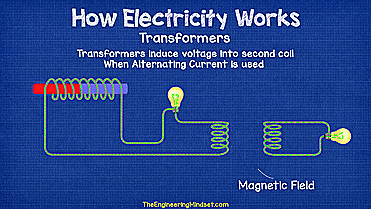
Transformers are a combination of all the points we’ve covered so far in this article. We can create two separate circuits and use a transformer to induce current from one circuit into the other.
By generating an AC current in a closed circuit and passing this current trough a coil, which is in close proximity to another coil in a separate closed circuit, we can create a transformer and induce a current from the first (primary) circuit into the second circuit.
Transformers can be used to increase or decrease the voltage between the primary and secondary circuits simply by changing the number of coils on either side.
Capacitors
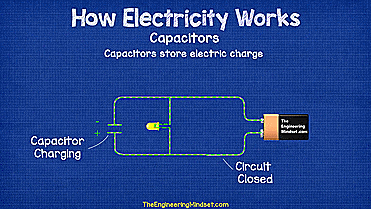
Capacitors force positive and negative charges to separate across two plates, when it is connected to a power supply. This causes a build up of stored electrons within an electric field. When a power supply is cut or interrupted these charges will then be released where they will then meet up and flow again. This provides a power source by only very briefly (seconds) as it will only last until the separated charges have met up again. This is slightly similar to a battery except it can’t maintain a power supply for as long.
Capacitors are very common and can be found in pretty much every electrical circuit.
AC and DC power
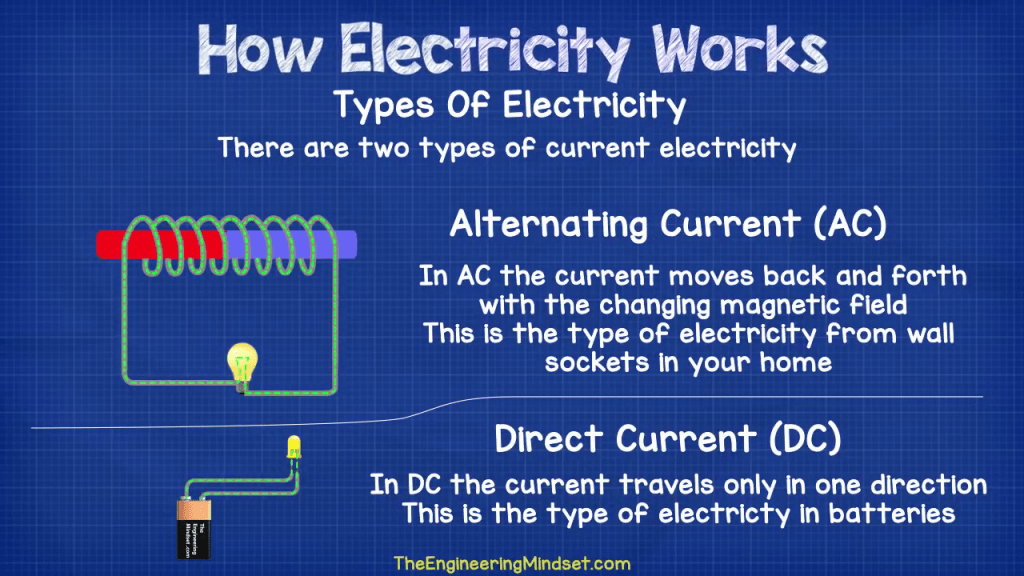
There are two types of power in use which are Alternating Current (AC) and Direct Current (DC)
Alternating current simply means the current flow backwards and forwards in a circuit as the terminals are constantly reversed. This is a bit like the tide of the sea, it goes in and out repeatedly. Alternating current is the most common type of electrical power and this is the type of power available in the power sockets of your home.
Direct Current simply means that the current flow directly in only one direction. This is what’s provided from batteries and Photovoltaic panels etc. This is most commonly used in portable electrical goods.
We can convert between AC and DC using inverters, this is how the AC power from our household power sockets can be used to charge our mobile phones which use DC power. Click here to learn how inverters work
Thank concludes this article for the basics of how electricity works. Below is a video tutorial on the subject with more information and animations.

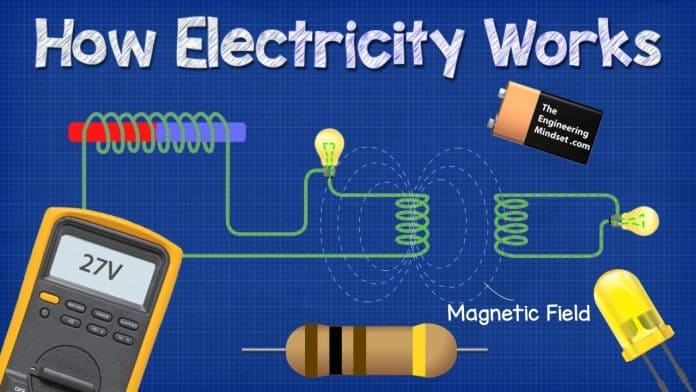


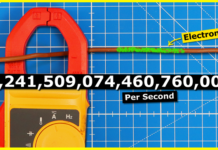
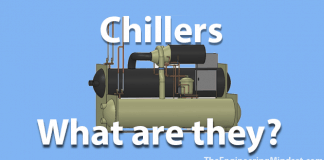
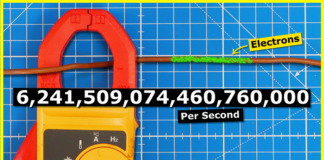
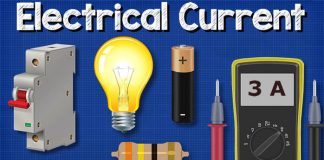
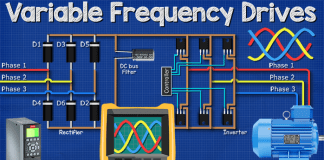

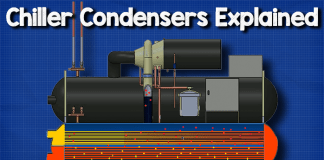
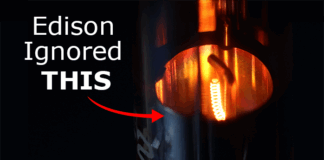







[…] Now if we place a magnet in between these coils and we start to rotate the magnet, then the magnetic field will disturb the free electrons within the copper wire and an electrical current will begin to flow. We’ve covered how the free electrons flow in our previous article on electricity basics so please check that out if you’ve not already done so. click here to view the video and article on how electricity works. […]
I quite like it 🙂 🙂 thanxs!!!!!!!
[…] valve we have the solenoid on top which is basically a coil of wire. As you may have seen in our electrical tutorial videos. When we pass an electrical current through a coil, we generate an electromagnetic field. This […]
[…] So far the animations detail the flow of electricity using DC or direct current which flows in one direction, like the flow of water down a river. This method is used because it’s simple to visualise and understand. However, electricity in your home actually flows forwards and backwards because it is AC or alternating current. It flows like the tide of the sea, back and forth constantly. Alternating current changes direction 60 times per second. Don’t worry too much about that for now. If you want to learn how electricity works then check out our simplified tutorial HERE. […]
Decent article; however, I noticed a mistake. Under the Atom heading, third paragraph, first sentence you wrote:
“The negative charge of the neutrons is attracted to the positive charge of the Proton which keeps the electrons in orbit.“
I believe the negative charge of the electrons, not the neutrons, that interacts with the positive charge of the protons.
Hi, I am interested in your youtube electrical lesson and I want become an electrician, How do I start ? Thanks
Are you planning to publish sapnish version of this video?
Yes, but a better version
In all of the examples, the power source is a battery.
I want to understand how the electricity in apartment buildings work – what is the power source in that case and how does the flow of electrons work?
I have spent a good couple of hours trying to wrap my head around the relationship between coulombs and amperes, and what I understand at this point, is that coulombs (C) are a unit to measure charge (Q), which is equal to the sum of charges of ~6.25 x 10^18 electrons, and it is not actually a measure of rate, just magnitude. The ampere is where rate comes in, and it is a coulomb per second, meaning the number of electrons that have a combined charge equivalent to a coulomb, flow past a single point in a conductor during the time span of 1 second. This means that 1 coulomb is actually an ampere-second, not actually the same thing as an ampere, and definitely not an ampere per second^-2. Your videos have been very helpful on the whole, genuinely really awesome, but that one thing was very confusing to me, because your description says, “1 Amp means 1 Coulomb per second and one coulomb equals 6,242,000,000,000,000,000 electrons per second.” which is not quite right as I understand it. Charge (in coulombs) is equal to current (in amps) MULTIPLIED by time (in seconds). If your statement were true, then Charge (in coulombs) would instead be equal to current (in amps) DIVIDED by time (in seconds). Coulombs would then be a unit for measuring the change in current rate each second, rather than just a measure of charge multitude. It’d be similar to acceleration (m.s^-2), if current were equivalent to speed(m.s^-1).
have spent a good couple of hours trying to wrap my head around the relationship between coulombs and amperes, and what I understand at this point, is that coulombs (C) are a unit to measure charge (Q), which is equal to the sum of charges of ~6.25 x 10^18 electrons, and it is not actually a measure of rate, just magnitude. The ampere is where rate comes in, and it is a coulomb per second, meaning the number of electrons that have a combined charge equivalent to a coulomb, flow past a single point in a conductor during the time span of 1 second. This means that 1 coulomb is actually an ampere-second, not actually the same thing as an ampere, and definitely not an ampere per second^-2. Your videos have been very helpful on the whole, genuinely really awesome, but that one thing was very confusing to me, because your description says, “1 Amp means 1 Coulomb per second and one coulomb equals 6,242,000,000,000,000,000 electrons per second.” which is not quite right as I understand it. Charge (in coulombs) is equal to current (in amps) MULTIPLIED by time (in seconds). If your statement were true, then Charge (in coulombs) would instead be equal to current (in amps) DIVIDED by time (in seconds). Coulombs would then be a unit for measuring the change in current rate each second, rather than just a measure of charge multitude. It’d be similar to acceleration (m.s^-2), if current were equivalent to speed(m.s^-1).
EDITED: I have spent a good couple of hours trying to wrap my head around the relationship between coulombs and amperes, and what I understand at this point, is that coulombs (C) are a unit to measure charge (Q), which is equal to the sum of charges of ~6.25 x 10^18 electrons, and it is not actually a measure of rate, just magnitude. The ampere is where rate comes in, and it is a coulomb per second, meaning the number of electrons that have a combined charge equivalent to a coulomb, flow past a single point in a conductor during the time span of 1 second. This means that 1 coulomb is actually an ampere-second, not actually the same thing as an ampere, and definitely not an ampere per second^-2. Your videos have been very helpful on the whole, genuinely really awesome, but that one thing was very confusing to me, because your description says, “1 Amp means 1 Coulomb per second and one coulomb equals 6,242,000,000,000,000,000 electrons per second.” which is not quite right as I understand it. Charge (in coulombs) is equal to current (in amps) MULTIPLIED by time (in seconds). If your statement were true, then Charge (in coulombs) would instead be equal to current (in amps) DIVIDED by time (in seconds). Coulombs would then be a unit for measuring the change in current rate each second, rather than just a measure of charge EDIT:[magnitude, not multitude]. It’d be similar to acceleration (m.s^-2), if current were equivalent to speed(m.s^-1).
I think what they are actually saying is that Amps=Coulombs/Second
Amps are the rate of current per second
Coulomb is an amount of electrons, not necessarily the combined charge of the electrons
However, what you said is also true, you flipped the equation around to state Coulombs=Amps x Seconds
It’s very hard to know this.
I think the hardest part of understanding electricity is how we naturally imagine it to be like water in a hose. But trying to imagine it as vibrations and frequency. I suspect we don’t actually understand electricity. I mean we harness it and use it, but trying to understand the earth or universe as frequency, vibration and wavelengths might lead to a new understanding of electricity. I’m curious how quantum mechanics might understand it differently.
This is very good explanation
Easy to understand, thanks
[…] LEARN MORE HERE: https://theengineeringmindset.com/how-electricity-works/ […]
[…] FIND OUT MORE HERE: https://theengineeringmindset.com/how-electricity-works/ […]
[…] you’ve ever wondered how electricity works, this article is for you. It’ll educate you about the incredible power of electricity. This […]
i am not a robot
I have a question that bothers me so much so that I’ve asked so many people but all i get is something beyond my comprehension. This is the case because they use very big technical words that just don’t make any sense to me. So here i am, with my question, hoping that maybe here someone might explain to me in terms that i can thoroughly understand. My question is somehow extended. it’s about “Current”(I). What determines the output current of a circuit? Let’s say, a charger for example? ‘coz I’ve seen different chargers with the same output voltages but different output currents. A charger with an output voltage of 5V and 2A and another one with the same 5V but 500mA. So please, explain this in simple terms as much as you can. This is my last hope to get a more in-depth and precise answer…
Hi
Duh duh duh
The following paragraph from the top of the above article is incorrect. In actual fact neutrons have no charge. They are neutral, hence the name. Perhaps the author could correct this error to avoid confusion of the readers.
“The negative charge of the neutrons is attracted to the positive charge of the Proton which keeps the electrons in orbit. Each orbital shell can hold a set number of electrons. The number of Protons, Neutrons and Electrons an Atom has tells us which material it is and the combination is unique for each material.”